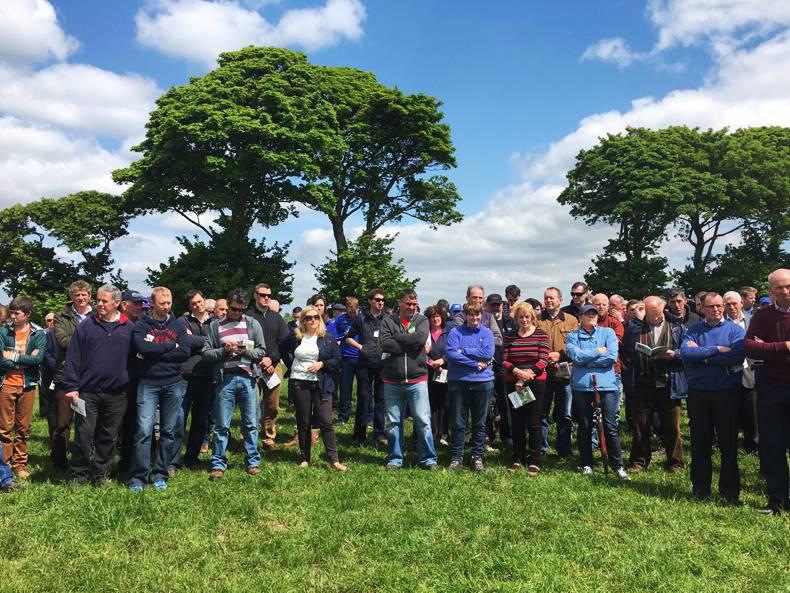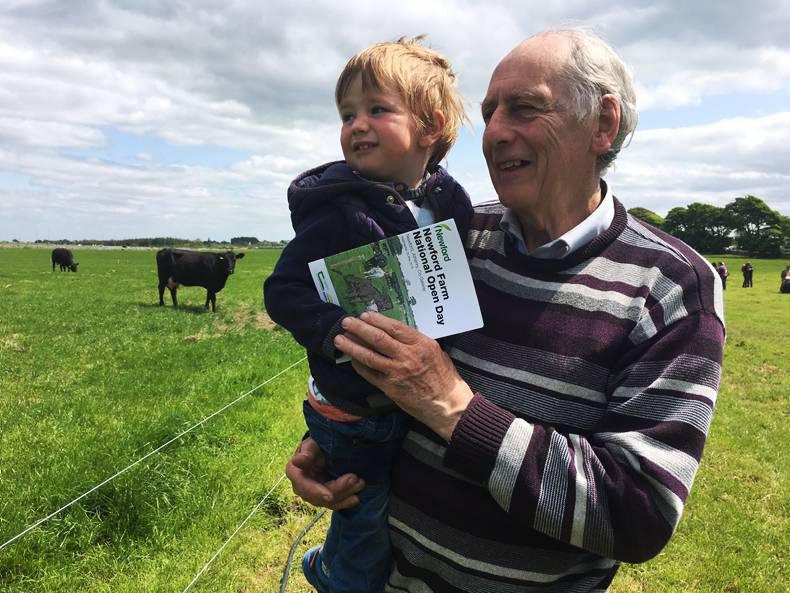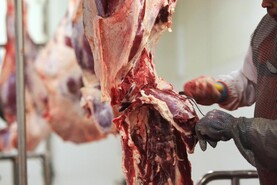Hundreds of farmers are expected to take part in the farm walks, which run every half-hour all afternoon this Wednesday until 7pm.
Massive crowds were in attendance from the start with many coming early, which is evidence of the interest in this alternate suckler system.
With 80% of stock finished before the second winter, there is no lull period in production here. This is a high-output system focussed completely on maximising profit.
The 100-cow suckler herd comprises mainly first-cross Aberdeen Angus cows as well as Hereford, bred from the dairy herd for their excellent milk yield potential off grass. This minimises the need for concentrates.
Visiting farmers were split as to whether this type of cow can be used.
Some accept that this may be the type of cows they will have to use. The docility of the herd and the amount of milk cows had attracted their attention. The quality of the calf impressed those that would not generally use Angus cows. Younger farmers more open, with education being key.
Older farmers, however, were still reluctant to change to these type of cows, with many saying they are not going to change from what they know.
Talking to farmers who had already changed to this type of system they were very happy with this type of cow and encouraged others to change.
Results so far
This year’s crop of 90 calves is on track to reach 50% of their mother’s weight within six months, with performance helped by the recent improved weather and a surge in grass growth at the farm.
The 56ha farm was established by Dawn Meats and Teagasc in 2015, with support from McDonalds and the Irish Farmers Journal. Over the five-year project, the farm aims to meet the following targets:
Improved profitability: Increase gross margin by over 130% in 5 years, from €495/ha in 2015 to €1,170/ha in 2020. This is more than double the €532/ha average for suckler farms according to the Teagasc eProfit monitor survey in 2014.Reduce variable costs: Newford aims to reduce variable costs as a percentage of total output from 74% in 2015 to 45% in 2020.Ambitious weight gain: Increase carcass weights of heifers from 280kg in 2015 to 330 kg in 2020, and from 295kg to 365kg for steersMaximise grazing: Targeting over 200 days on grass based on a high stocking rate of 2.7 livestock units per hectare.“We are encouraging farmers to focus on the profitability and efficiency of their farm system rather than showcasing what might be a very good looking animal, but one that isn’t what the market is looking for and cannot be reproduced consistently. What farmers may lose in carcass size they will more than make up for through the lower cost of production,” said farm manager Matthew Murphy.
Hundreds of farmers are expected to take part in the farm walks, which run every half-hour all afternoon this Wednesday until 7pm.
Massive crowds were in attendance from the start with many coming early, which is evidence of the interest in this alternate suckler system.
With 80% of stock finished before the second winter, there is no lull period in production here. This is a high-output system focussed completely on maximising profit.
The 100-cow suckler herd comprises mainly first-cross Aberdeen Angus cows as well as Hereford, bred from the dairy herd for their excellent milk yield potential off grass. This minimises the need for concentrates.
Visiting farmers were split as to whether this type of cow can be used.
Some accept that this may be the type of cows they will have to use. The docility of the herd and the amount of milk cows had attracted their attention. The quality of the calf impressed those that would not generally use Angus cows. Younger farmers more open, with education being key.
Older farmers, however, were still reluctant to change to these type of cows, with many saying they are not going to change from what they know.
Talking to farmers who had already changed to this type of system they were very happy with this type of cow and encouraged others to change.
Results so far
This year’s crop of 90 calves is on track to reach 50% of their mother’s weight within six months, with performance helped by the recent improved weather and a surge in grass growth at the farm.
The 56ha farm was established by Dawn Meats and Teagasc in 2015, with support from McDonalds and the Irish Farmers Journal. Over the five-year project, the farm aims to meet the following targets:
Improved profitability: Increase gross margin by over 130% in 5 years, from €495/ha in 2015 to €1,170/ha in 2020. This is more than double the €532/ha average for suckler farms according to the Teagasc eProfit monitor survey in 2014.Reduce variable costs: Newford aims to reduce variable costs as a percentage of total output from 74% in 2015 to 45% in 2020.Ambitious weight gain: Increase carcass weights of heifers from 280kg in 2015 to 330 kg in 2020, and from 295kg to 365kg for steersMaximise grazing: Targeting over 200 days on grass based on a high stocking rate of 2.7 livestock units per hectare.“We are encouraging farmers to focus on the profitability and efficiency of their farm system rather than showcasing what might be a very good looking animal, but one that isn’t what the market is looking for and cannot be reproduced consistently. What farmers may lose in carcass size they will more than make up for through the lower cost of production,” said farm manager Matthew Murphy.






 This is a subscriber-only article
This is a subscriber-only article















SHARING OPTIONS: